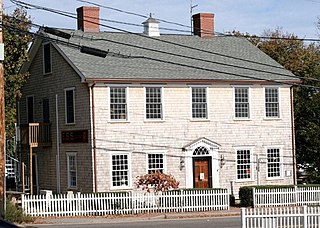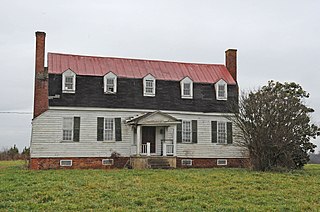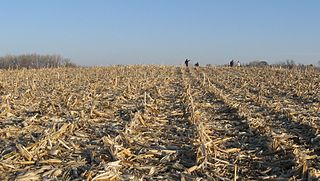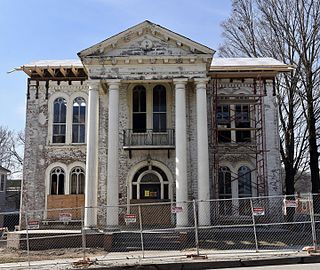
Berkeley Plantation, one of the first plantations in America, comprises about 1,000 acres (400 ha) on the banks of the James River on State Route 5 in Charles City County, Virginia. Berkeley Plantation was originally called Berkeley Hundred, named after the Berkeley Company of England. In 1726, it became the ancestral home of the Harrison family, after Benjamin Harrison IV located there and built one of the first three-story brick mansions in Virginia. It is the home to two presidents of the United States: William Henry Harrison, and his grandson Benjamin Harrison. It is now a museum property, open to the public.

The Missouri Botanical Garden is a botanical garden located at 4344 Shaw Boulevard in St. Louis, Missouri. It is also known informally as Shaw's Garden for founder and philanthropist Henry Shaw. Its herbarium, with more than 6.6 million specimens, is the second largest in North America, behind that of the New York Botanical Garden. The Index Herbariorum code assigned to the herbarium is MO and it is used when citing housed specimens.

Will Mayfield College was a Baptist school located in Marble Hill, Missouri. From 1878 to 1934, the college offered four years of preparatory school and two years of junior college work.

Missouri Valley College is a private liberal arts college that is affiliated with the Presbyterian Church (USA) and located in Marshall, Missouri. The college was founded in 1889 and supports 40 academic majors and an enrollment close to 1,500 students. Missouri Valley College is accredited by the Higher Learning Commission, a Commission of the North Central Association of Colleges and Schools.

Roseland Cottage, also known as Henry C. Bowen House or as Bowen Cottage, is a historic house located on Route 169 in Woodstock, Connecticut, United States. The house was added to the National Register of Historic Places in 1977, and was declared a National Historic Landmark in 1992. It is described as one of the best-preserved and best-documented Gothic summer houses in the nation, with virtually intact interior decorations.

The Ritter House is an historic house on Beach Street in Vineyard Haven, Massachusetts, USA, and is listed on the National Register of Historic Places. The house is one of the few remaining Federal period buildings in Vineyard Haven. It has had a succession of occupants and uses, and as of 2007 served as a retail establishment.
Harrison House may refer to:

Hunting Quarter is a historic plantation house located near Sussex Court House, Sussex County, Virginia. The main house was built between 1745 and 1772, and is a 1 1/2-story, five bay, single pile, center hall, frame dwelling. It has a gambrel roof with dormers and exterior end chimneys. Attached to the main section is a rear ell added in 1887, and two small porches added in the 20th century. Also on the property are a contributing smokehouse, the sites of four outbuildings, the Harrison family cemetery, and a slave cemetery. Hunting Quarter was built by Captain Henry Harrison, son of Benjamin Harrison IV of Berkeley. During the French and Indian War, Captain Harrison was stationed at Fort Duquesne, he served as a captain under Major General Edward Braddock and later under Lieutenant Colonel George Washington. Captain Harrison was a brother of Benjamin Harrison V, signer of the Declaration of Independence and the fifth Governor of Virginia. Captain Harrison was a breeder of Thoroughbred horses. Silver Heels, perhaps his most famous race horse, was listed among other Thoroughbreds in the inventory of his estate taken after his death in 1772. According to tradition, a walking cane that belonged to US President William Henry Harrison, a nephew of the builder, once hung over one of the mantels in the house. Captain Harrison is buried in the Harrison family cemetery on the property. "Hunting Quarter" remained in the Harrison family until 1887.

Kimball Village is an archaeological site located in the vicinity of Westfield, Iowa, United States. It is one of six known Big Sioux phase villages from the Middle Missouri Tradition that existed between 1100-1250 C.E. The site, located on a terrace overlooking the Big Sioux River, has well-preserved features, including earth lodge and storage pits, and evidence of fortifaction. The site was listed on the National Register of Historic Places in 2010, and as a National Historic Landmark in 2016.

Huhn-Harrison House is a historic home located at Cape Girardeau, Missouri. It was built in 1905–1906, and is a 1+1⁄2-story, free classic Queen Anne style brick dwelling. It features a wrap-around porch with classical columns for porch supports and a rounded corner.

Courthouse–Seminary Neighborhood Historic District is a national historic district located at Cape Girardeau, Cape Girardeau County, Missouri. The district encompasses 121 contributing buildings and 2 contributing sites in a predominantly residential section of Cape Girardeau. It developed between about 1848 and 1948, and includes representative examples of Italianate, Queen Anne, Colonial Revival, Tudor Revival, Mission Revival, Late Gothic Revival, American Craftsman, and Art Deco style architecture. The district contains 1 1/2 and 2 1/2-story brick single-family homes, with multi-family homes and a few commercial buildings dispersed throughout. Located in the district is the separately listed Robert Felix and Elma Taylor Wichterich House, William Henry and Lilla Luce Harrison House, Huhn-Harrison House, B'Nai Israel Synagogue, St. Vincent de Paul Catholic Church, August and Amalia Shivelbine House, Glenn House, House at 323 Themis Street, and George Boardman Clark House.

William Poeschel House, also known as the Poeschel-Harrison House, is a historic home located near Hermann, Gasconade County, Missouri. It was built about 1869, and is a two-story, ell-shaped, red brick dwelling. It features a two-story, gable-roofed portico, and a two-story porch that spans the east side of the rear ell.

Luce-Dyer House, also known as the Stark-Carlson House, is a historic home located at Louisiana, Pike County, Missouri. It was built between about 1856 and 1860, and is a two-story, three bay, Italianate style brick dwelling. It features a bracketed cornice, gabled roofline, five pairs of semi-circular topped windows with oscula, and pedimented Neoclassical front portico added in the 1930s. Also on the property are the contributing garage and cottage.

North Third Street Historic District is a national historic district located at Louisiana, Pike County, Missouri. The district encompasses 61 contributing buildings, one contributing site, and contributing structure in a predominantly residential section of Louisiana. It developed between about 1843 and 1935, and includes representative examples of Greek Revival, Gothic Revival, Italianate, Queen Anne, Colonial Revival, and Bungalow/American Craftsman style architecture. Located in the district are the separately listed Louisiana Public Library and Luce-Dyer House. Other notable buildings include the William C. Hardin House, James H. Johnson House, Edward G. McQuie House, St. Joseph's Catholic Church (1874), and Frank Boehm, Jr. House.

Elim, also known as the Dr. William Keil House, is a historic home located near Bethel, Shelby County, Missouri. It was built in the late-1840s, and is a 2+1⁄2-story, brick and stone dwelling over a full basement. It has a simple ridge roof and two porches. It was built by the members of the Society of Bethel and served as the residence of the society's founder Dr. William Keil (1812-1877).

Harrison Queen House is a historic home located near Caledonia, Missouri. It was built about 1875, and is a 1+1⁄2-story, single-pen log house, measuring 16 by 18 feet. It features an exterior limestone chimney.

The Hagerty House, also called the Hagerty-Harris House, is a two-story house located on 505 East Rusk Street in Marshall, Texas. Built in 1889 by Thomas Higgins, it was the first solid brick residence in Marshall. It was built for William Phillip Hagerty, personal engineer of Texas and Pacific Railroad president George J. Gould by railway craftsmen. Born in 1848 in Ireland during the Great Famine, Hagerty was likely to be arrested by the British government due to his nationalist activities when he emigrated in 1866 to the United States.

The General William Henry Harrison Headquarters is a historic building in the East Franklinton neighborhood of Columbus, Ohio. It was listed on the National Register of Historic Places in 1972 and the Columbus Register of Historic Properties in 1985. The brick house was built in 1807 by Jacob Oberdier, one of Franklinton's first settlers. The house became especially important to the area from 1813 to 1814, when General William Henry Harrison, later the 9th President of the United States, used the house as his headquarters. It is the only remaining building in Ohio associated with Harrison.

The Henry D. and Juliana (Wortz) Albright House, also known as the Dr. Francis F. and Jeanette L. Ebersole House, is a historic building located in Mount Vernon, Iowa, United States. It is significant for its association with the settlement of the city that was influenced by the establishment of the Military Road, as the first brick house constructed in Mount Vernon, and its vernacular architectural techniques. Henry D. Albright, a carpenter, and his brother William, a mason, came from Iowa City to Mount Vernon to work on building Cornell College. William established a brickyard in town and he helped his brother Henry build this house in 1853. Henry and his wife Juliana and their family were the first to live here. The family owned the house until 1926. Dr. F.F. Ebersole acquired the house that year and completed renovations to the house the following year to include his medical practice in his home. The two-story, side-gabled brick house features Early Republic stylistic influences. Locally made brick from the Albright brickyard and locally quarried limestone was used in its construction. The house was listed on the National Register of Historic Places in 2020.




















